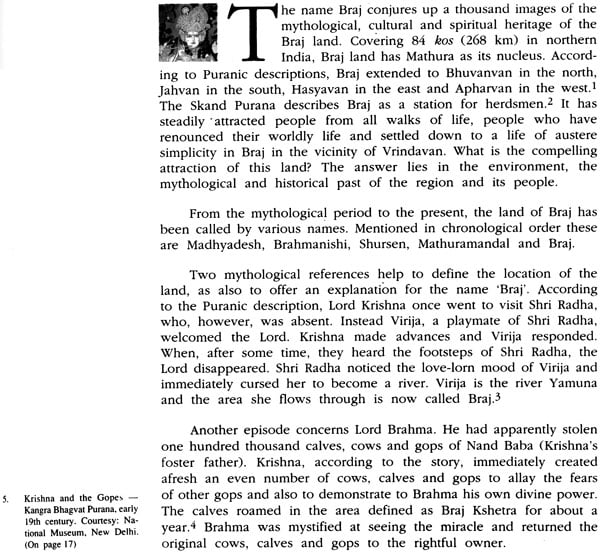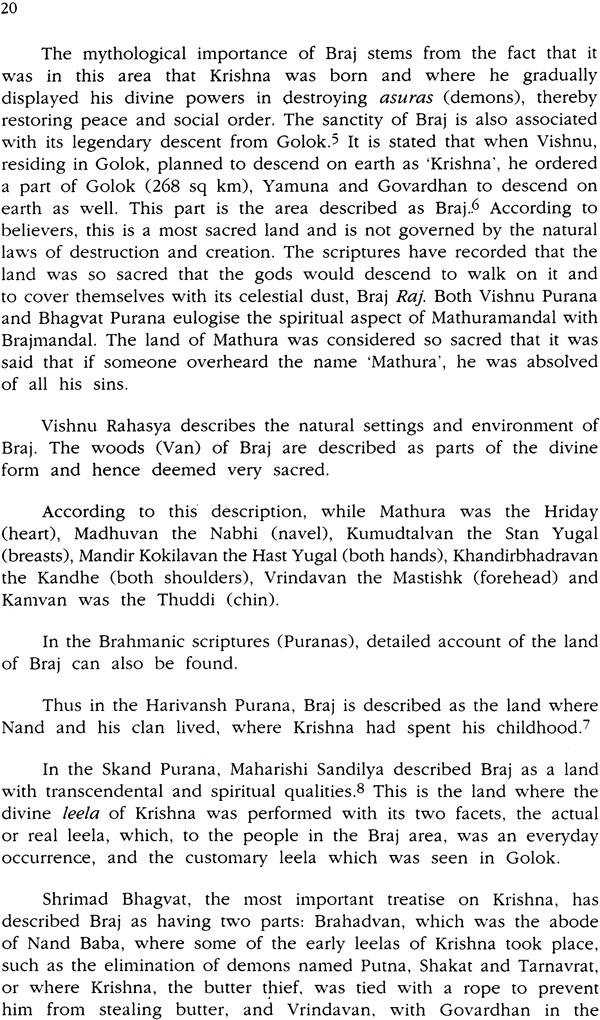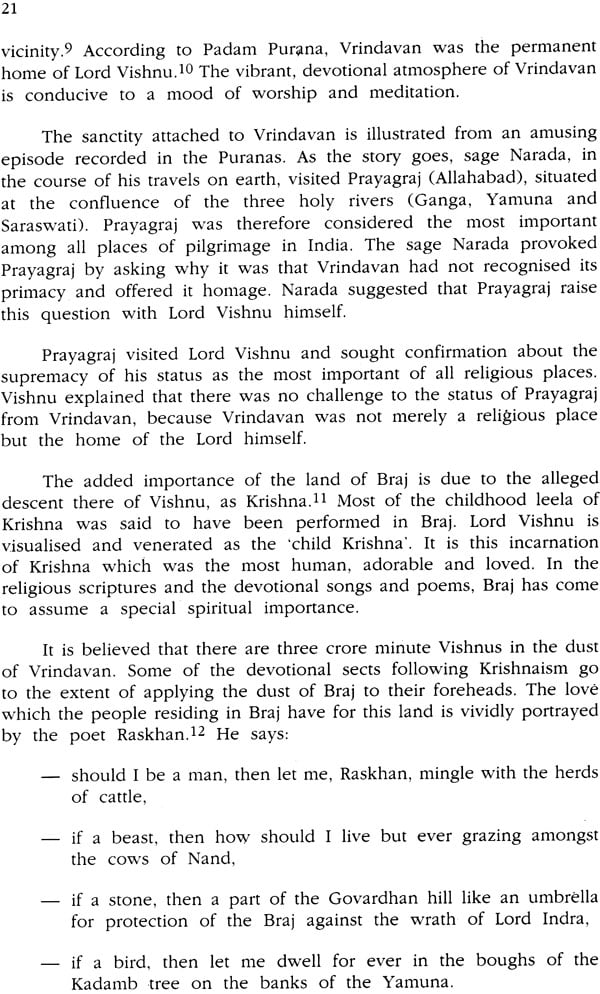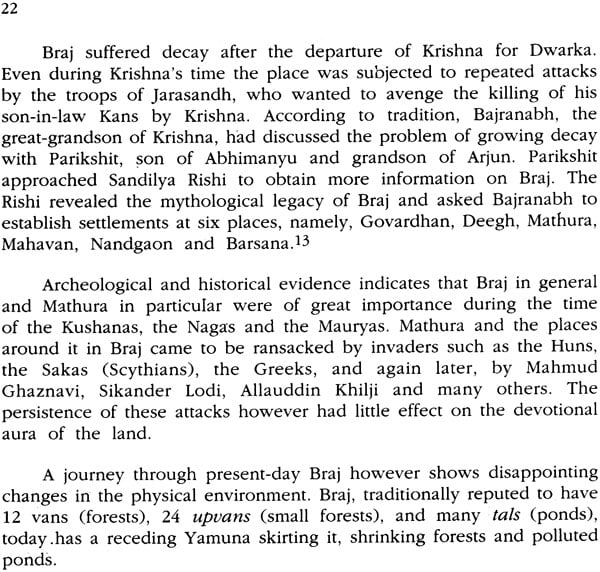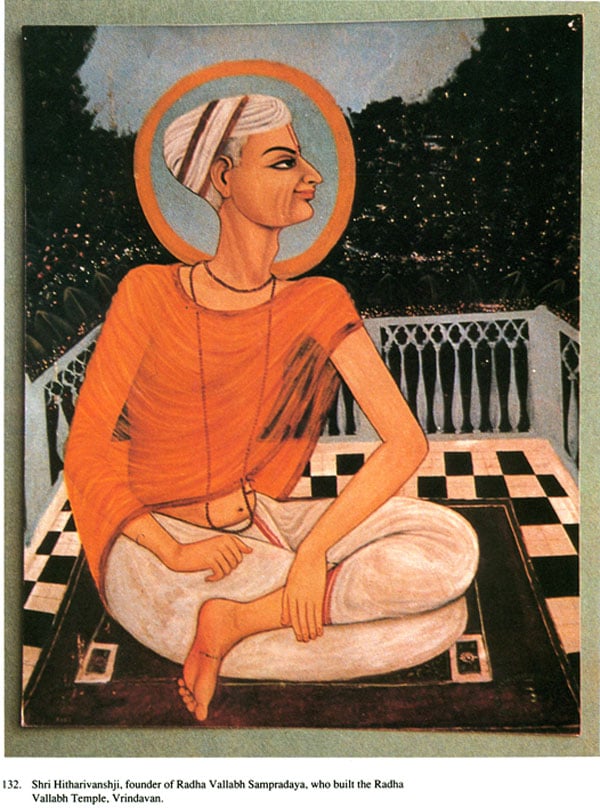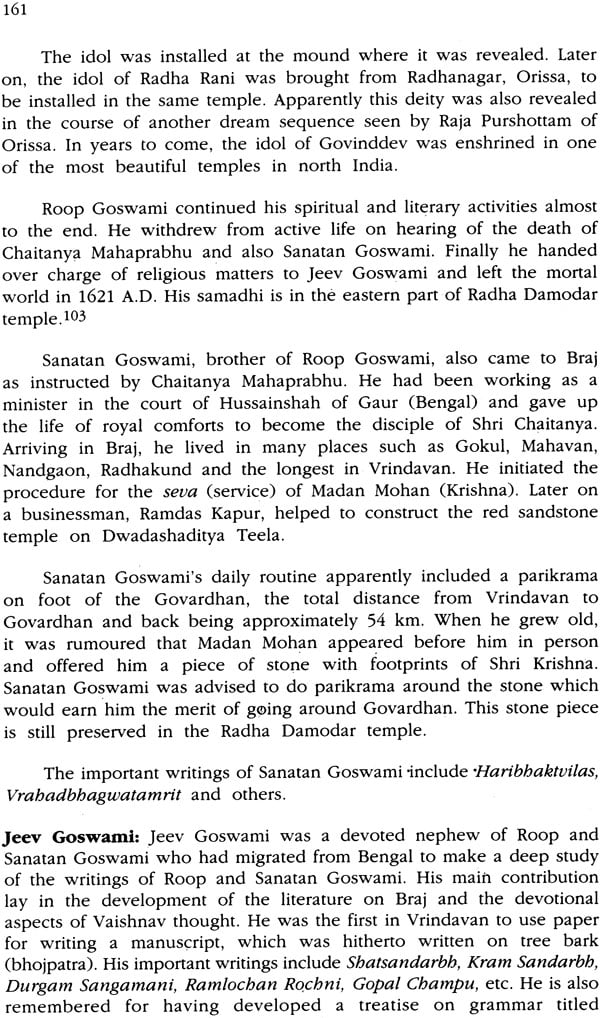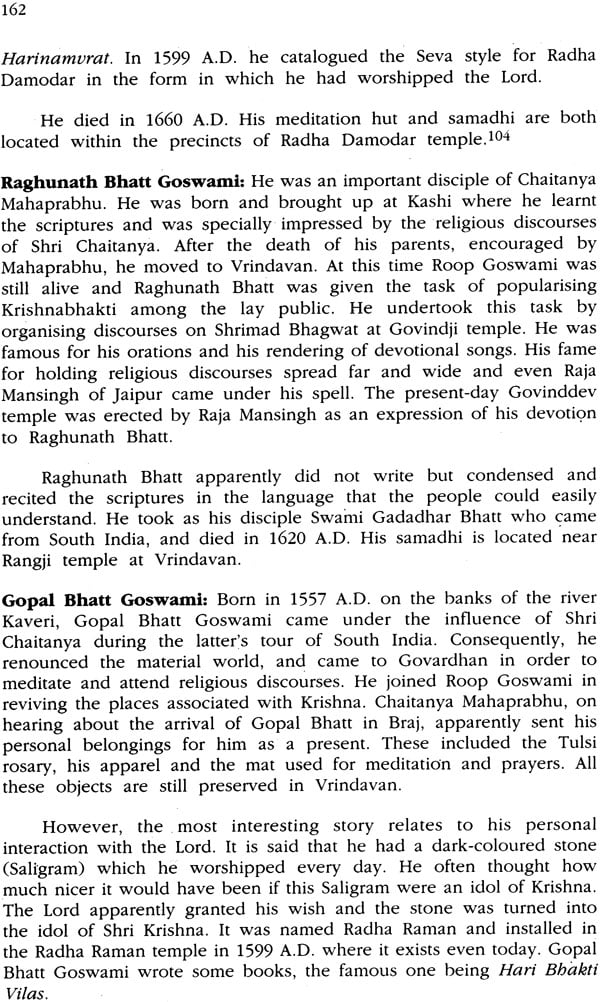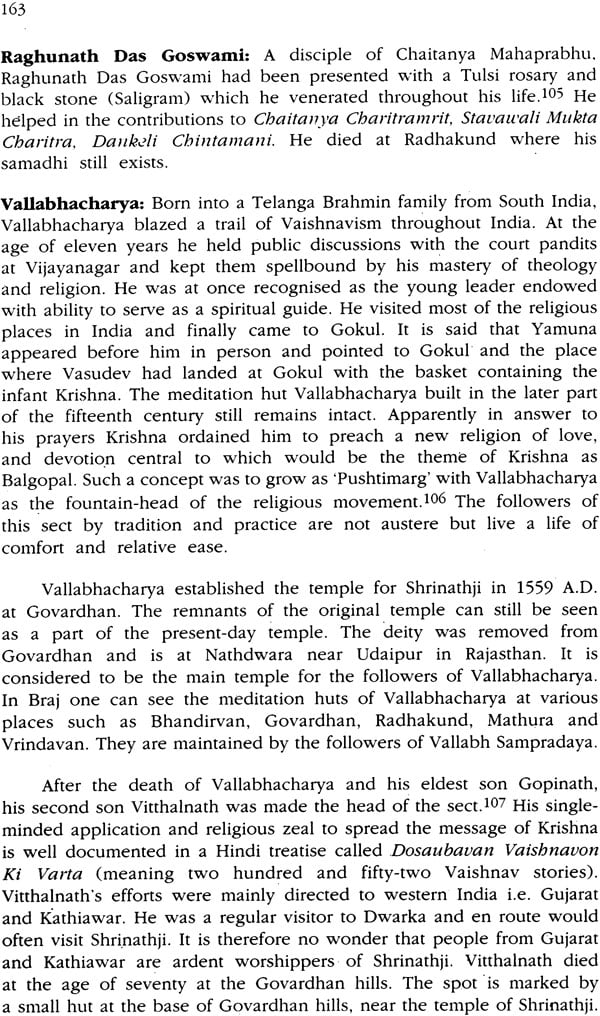
Krishna The Living God of Braj
Book Specification
| Item Code: | IDJ979 |
| Author: | D. Anand |
| Publisher: | ABHINAV PUBLICATION |
| Language: | English |
| Edition: | 1992 |
| ISBN: | 8170172802 |
| Pages: | 221 (191 Colour Illustration) |
| Cover: | Hardcover |
| Other Details | 11.0 inch x 9.0 inch |
| Weight | 1.12 kg |
Book Description
About the Book
Lord Krishna occupies a unique place in the minds and hearts of the people of India. The child and adolescent Krishna provided inspiration to poets like Jayadeva, Surdas, Keshavdas, Rahim Khan-khana to name only a few. The adult Krishna is remembered as a counselor of princes in peace and war, just ruler and above all as the incarnation of the supreme being, who revealed the Geeta, which is the fountainhead of social, spiritual and moral thought of Hindu India. It is from all these attributes that Vallabhacharya, the founder of Pushti Marg, referred to him as Purushottam-the complete (Purna) incarnation of the Divinity.
Over the yeas the impact of Krishna's life has been portrayed in a variety of ways. Devotee like Chaitanya Mahaprabhu, Meerabai, Sant Tukaram and many others sang songs in praise of Krishna.
Krishna's impact continues to be portrayed in the paintings and the performing arts of India. During the past 40 years a number of books have been published which focus either on the different styles of paintings and sculptures or illustrate the traditional folk and classical forms of dance, portraying the life of Krishna.
Almost all the illustrated books have so far touched only the images drawn by the artists in creative and performing arts. This gives little indication of the vast sweep of Krishna's impact on the life of India. The Braj Bhumi, where Krishna was born and lived the early part of his life, provides ample evidence of the innumerable ways in which the divine self is venerated, worshipped and remembered, as a way of life. It is the Braj Bhumi where the devotees, the poets and saints converged in the past to seek inspiration from this sacred land. The areas is full of landmarks left by the saints, who sang the glory of Lord Krishna and left their marks enshrined in the form of temples, samadhis and festivals, that perpetuate the Lord's message. Unfortunately many of these milestones are in a state of disrepair and may soon be lost in the sands of time.
About the Author
Dr. Anand, physician by profession, has devoted the better part of last 5 years researching, interviewing the people and photographing the land where Lord Krishna and Radha were born and grew up.
He presents the legends that have provided spiritual sustenance to millions of Indians for thousands of years, while the photographs would enable the reader to truly get a feel of the and, its people and its temples that are still revered by millions around the world.
Introduction
This work on Krishna of Braj is the fulfilment of a dream nursed for almost forty years. My initial curiosity in Krishna was aroused in nineteen hundred of Gursarai in district Jhansi wearing country-made shoes with the motif of a peacock feather embroidered on them. It was unmistakably meant to depict the headwear of Krishna! The people of the village considered themselves to be the descendants of the legendary King Chediraj Shishupal, who had been killed by Krishna when the Rajsuya Yagya was being held by Yudhisthara. The People being the subjects of Shishupal held the enemy of their king in perpetual disgrace. This interpretation produced a powerful impact on my mind. It only added to my curiosity to know more about Krishna who is loved, venerated, respected, and even disrespected, in the same country, India.
The other reason for undertaking this venture came from a perusal of illustrated books on Krishna that have been published in India and abroad. Many of these books use the Krishna theme to present paintings of different styles. Such as Kangra or Mewar. The others describe a variety of performing arts using the Krishna theme. All these people in this India abroad the story of Krishna, the Living God whose vibrant thoughts bring to many a sense of peace and joy. This is very apparent in Braj, the land of Krishna's birth, where chanting the name of Shri Krishna and Shri Radha forms an essential part of the everyday existence of the local people. They glean a sense of happiness and satisfaction by simply living in Braj. I felt that a camera is the most suitable medium to convey this living aspect of people's interaction of Radha and Krishna in day-to-day life.
The present effort provides visual images of various temples and places associated with the Krishna legend. Only a camera can effectively capture the beauty of the temples of Govindji or Madan Mohan in Vrindavan, or the panoramic oriental landscape of Radhakund. Many of these places are at present in a state of neglect and decay and many disappear altogether. This book attempts to provide a graphic and pictorial record of the places identified in the Puranas or other ancient literature for their association with the legend of Shri Krishna.
For purposes of description, the book has been divided into five Sections:
Place: The Photograph over the important sites associated with the Krishna legend in Braj. The accompanying maps of Braj (area: 268 sq km) and Vrindavan will help in identifying the important sites that have been covered.
Temples: Mathura, Vrindavan and almost all the villages in their neighbourhood are full of temples for worshipping Shri Radha and Shri Krishna. The main temples of Mathura, Vrindavan and other important places have been photographed. This would give some idea of the varied forms in which Krishna is worshipped in a cross-section of the temples of Braj.
It has not been possible to photograph the presiding deity of all the famous temples. In some, like Bihariji's at Vrindavan, taking of photographs is strictly prohibited. At other places, it is a matter of discretion of the priest who performs puja. In all such cases, the sensitivities of the local priests have been respected.
Famous Devotees: Braj has historically attracted people from all over India to come in search of divine and contemplation. This tradition has continued to the present period, during which Shri Bhaktivedanta Swami Prabhupada came to Braj to seek enlightenment and spread the message of love and devotion throughout the world. This section provides an account of these devotees, the places they stayed in and their contribution to Krishnaism and the cultural heritage of Braj.
Fairs and Festivals: Krishna and his divine consort are the central theme in all the festivals held in Braj. Some are exclusively related to their presence, such as the birthdays of Radha and Krishna. The others like 'Holi' develop a unique flavour because of the association with Shri Radha. The festivals therefore result in both devotion and gay abandon which are captured by the camera in this section.
Creative and Performing Arts: According to tradition, Krishna was also known to be a great dancer. His flute charmed the Gops and Gopis and has been immortalised in the romantic poems and songs of famous poets. The local artists cover a wide range of art forms such as making a house of flowers or designing motifs on earth with dry, coloured powder. This section covers the range of artistic activities that are mostly associated with Krishna and are peculiar to the land of Braj.
The work on this book started about five years ago. It has taken almost four years since the work began with shooting the first sequence of pictures in Vrindavan. Since them my camera and I have traversed the length and breadth of Braj. There were moments of despair, sometimes frustration, but there was always an overriding feeling of confidence that one day the work would be completed. That they has come and it would be the end of the trail that started five years ago, and was dreamt about 40 years ago. I will now miss visiting the familiar faces all over Braj of those who have been kind and have shared their thoughts, wisdom and hospitality of make this voyage come through. All those faces come alive as I pen these words. I can only thank all my friends and Brajbasis who gave me the strength and the opportunity to complete this work.
After the initial exploratory work, it was realized that it could not be undertaken single-handed. It would be difficult to photograph places and people unless one knew the background of the places to be photographed, and also, unless one had the concurrence of the local people/pundits. It therefore became essential to have a team of persons familiar with Braj and the writings related to this land. I was lucky to have met a large number of people from all walks of life, who shared their views with me and provided help, often going out their way. It is not easy to remember and thank every one of them. However, it would be remiss of me not to specially mention Pundit Ramesh Chand Goswami of Barsana, Shri Pulin Goswami, Shri Shri Vats, Shri Vrindavan Bihari, U.B. group for their support and Smt. Reba Som whose valued comments and help facilitated this work.
The most indispensable help came from a charming young couple, Dr. Sadhana and Dr. Kumud Kulshrestha. Sadhana, a keen photographer, with doctoral research on various aspects of Vrindavan, took personal interest in this work. Her major contribution has been the research conducted on the Krishna legend which has been vital for my photography. She has done this very creditably with some assistance from her husband, Dr. Kulshrestha.
During the course of this project, I often felt lost because of the magnitude of the work to be undertaken. It required visiting remote and little-known places. It was also important to identify the most opportune time to photograph an event or a place, such as temples at a particular time or a special occasion. The travel back and forth from Delhi to Mathura and Vrindavan meant expenses not easily anticipated. Hence, an attempt was made to apply for a grant to cover the production cost. This exercise has provided a new insight into the existing interest in art and the cultural heritage of India.
There are practically no funds for a rank outsider to venture on such a project. After a repeated 'no' from many institutions and organizations in India and elsewhere, I decided to do it on my own. The Krishna project became a full-time occupation. The moral support for completing this work came from many familiar as also many unknown faces. My daughter Mridu and her husband Satish, as also my son Pradeep and his wife Rohini, encouraged me to complete the work. They all, in their won way, have helped in the preparation of the manuscript. Recharging of flagging spirits was provided by meeting Indian friends, many of them abroad, specially in the USA. The Keen interest shown at the various illustrated talks on Braj that were organized in the USA was most encouraging.
Foreword
Krishna, the living God of Braj, inspires and evokes love and joy as much as He demands faith, devotion and, above all, surrender. Krishna is that mythic image of the Indian consciousness that is ever-present, moving in and out, playing hide-and-seek with time past and time future. To try and seek either historicity or to weave a pattern of rationality is to confine the power of the moving clouds in the sky to measurable volumes of geometry. Studies on Krishna are, therefore, as innumerable as the visions which this mythic image invokes in the minds of those who are drawn to it.
Whether historically true or not, Krishna was born in the Braj kshetra and He moved to Dwarka later. What is important is that the whole Kshetra of Braj is sacred because of the mythic Krishna permeates the Kshetra. Here and now, the lanes and bylanes of Vrindavan reverberate in the inner ears of the devotees with the flute of Krishna. Groves and shrubs are made sacred each day anew through faith and devotion of the Bhakatas. The loves of Krishna and the Gopis and Krishna and Radha are recreated each day, each moment.
In whatever hoary antiquity the myth was created or the historical figure born, Krishna of Harivansh Purana and the Vishnu Purana is rejuvenated in the Shrimad Bhagvat. This already takes nearly a thousand years. Another 500 years passed before the Kshetra of Braj comes alive with new vigour and renewal of the imagery of Krishna. Now it is the centre of the Krishna lore and Indians from all parts of India converged, as they converge today, to be in communion with this living presence.
Dr. Anand has been magnetically pulled and attracted by this living God, as many others. The book is a sheer labour of love in which he explores the physical, historical, ritual and artistic dimensions of the Braj Kshetra. The joy of playfulness of Krishna, the fairs and the festivities, the medieval temples and the paintings, the contemporary music and dance, the floor drawings of the Sanjhis, are captured through a lense with a loving eye. I have no doubt that anyone who read this book and sees the photographs will respond to the enchanted world of Krishna, the Living God.
Contents
| Foreword | 8 | |
| Introduction | 9 | |
| Braj | 17 | |
| Krishna | 25 | |
| Place and Temples | 41 | |
| Braj Parikrama | 113 | |
| Fairs and Festivals | 123 | |
| Devotees | 151 | |
| Creative and Performing Arts | 171 | |
| References | 207 | |
| Glossary | 211 | |
| Index | 217 |
